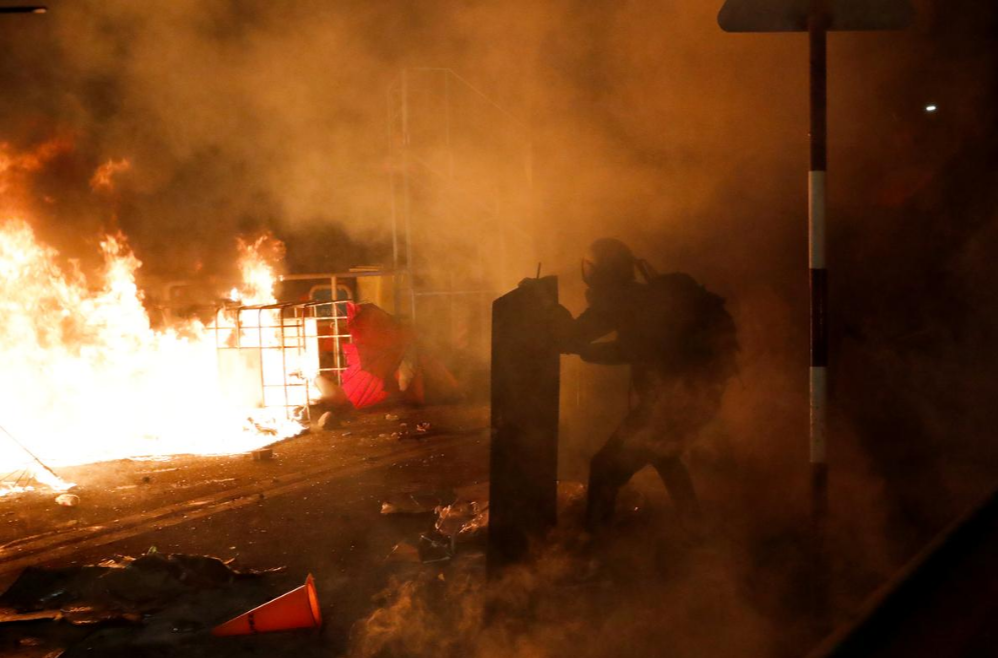06:37

Monday (Nov. 11) is said to be one of the worst days of violence since protests erupted in the city in June. Protesters paralyzed roads and forced the closure of more than 32 railway stations throughout the day.
More than 260 people were arrested that day, according to police. One particularly appalling scene happened when rioters set a resident on fire in the Ma On Shan area. The man was seen standing in front of the group expressing an opposing view. A bottle of flammable liquid was then poured on him before someone quickly set him alight. The gang fled the scene immediately, leaving him in flames. The man suffered multiple burns and was rushed to the hospital. He's now reported to be in a critical condition.
Also the same day, footage circulated online showing a group of black-clad rioters harassing a young woman who tried to walk away. They stopped her repeatedly before assaulting her with sticks and spraying her with fire extinguishers.
Violence was not only inflicted on Chinese people, but also a foreigner. A Japanese man was injured in an assault by rioters in a major shopping district on the Kowloon Peninsula. The man was shooting a video of what was happening on the street before being beaten and bloodied. The Japanese Foreign Minister confirmed the Japanese national was attacked, although exactly why he was beaten up was still being investigated. It's alleged he was mistaken as someone who came from the Chinese mainland.
Amid the escalating violence, the Hong Kong Police responded even more resolutely. On Monday morning, a policeman shot at a rioter on duty. The man was hospitalized, and reportedly, not in a life-threatening condition.
So yet another dark day in the five months of unrest.
Immediately, Hong Kong was back in the international media spotlight. The most astonishing thing was how young and supposedly righteous youths could set an unarmed person on fire. However, mainstream international media focused almost exclusively on the police shooting. Some did mention the burning but in such a matter-of-fact way as if it was just another machine being set ablaze. For instance, The Guardian published an article on Monday, the day when the incident happened.
The title reads:"Hong Kong protests: Man shot by police and burns victim in critical condition." A weird sentence to say the least. The passive use of language omits conveniently the people who carried out the atrocity of burning someone alive.

The standoff at CUHK has been violent and intense. Police have described the clashes as "deadly." /Reuters Photo
The standoff at CUHK has been violent and intense. Police have described the clashes as "deadly." /Reuters Photo
Immediately after the headline, the article says: "Police fire at unarmed student and middle-aged man set on fire in a day of violent clashes."
So the student was unarmed, but what about the middle-aged man? Was he armed? No. Why did the journalist not include that fact too? Also, what makes a student different from a middle-aged man in the eyes of the law?
The biggest problem is — the article puts the police doing their job on par with civilians trying to kill a fellow civilian. Is that how people treat innocent people in the UK or elsewhere around the world? If this were to happen in the UK or elsewhere, would the journalist have had the guts to write it this way and would the paper have had the guts print it?
Some would argue that the police was using excessive force while doing their job. Well, in times of escalated violence the police have the right and obligation to step up the use of force to protect not only themselves but also the wider public. But if you look at the details of that video, there is another story going on there.
From the original unedited video, you can see the policeman pointing the gun at the black-clad man, while trying to subdue another rioter. But the man continued to approach him, even attempting to snap the gun from the policeman. That's when the shot was fired.
But if you look at the video published by The Guardian, strangely, the moment the rioter tries to grab the gun from the policeman was edited out.
Why edit out such a critical moment that is vital to understanding the events which unfolded? The cut version certainly seems to make the protester look more innocent and the police appear more brutal in his actions. What motivated The Guardian to make this editorial choice? Was it perhaps to not only gloss over the human burning incident while trying their best to justify the legitimacy of the protest movement long after it turned violent.
The second case in point is the CNN coverage on that day.
It was evident that police brutality was dominating the headlines, but not the rioters setting an innocent man on fire.
CNN published a total of eight stories about Hong Kong on Monday, two of which were about the man who was set on fire, while the rest six detailed the 21-year-old "student" being shot. Is the former not as cruel and callous as the latter? Is the former not "premeditated" and as severe as a policeman trying to contain a volatile situation?
At the very least, isn't an equal, balanced coverage of both incidents the right and proper way to tell the Hong Kong story?
(If you want to contribute and have specific expertise, please contact us at opinions@cgtn.com.)